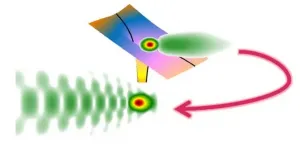(Press-News.org) Eating a diet rich in omega 3 (n-3) fatty acids reduces the frequency of headaches compared with a diet with normal intake of omega 3 and omega 6 (n-6) fatty acids, finds a study published by The BMJ today.
Modern industrialised diets tend to be low in omega 3 fatty acids and high in omega 6 fatty acids. These fatty acids are precursors to oxylipins - molecules involved in regulating pain and inflammation.
Oxylipins derived from omega 3 fatty acids are associated with pain-reducing effects, while oxylipins derived from omega 6 fatty acids worsen pain and can provoke migraine. But previous studies evaluating omega 3 fatty acid supplements for migraine have been inconclusive.
So a team of US researchers wanted to find out whether diets rich in omega 3 fatty acids would increase levels of the pain-reducing 17-hydroxydocosahexaenoic acid (17-HDHA) and reduce the frequency and severity of headaches.
Their results are based on 182 patients at the University of North Carolina, USA (88% female; average age 38 years) with migraine headaches on 5-20 days per month who were randomly assigned to one of three diets for 16 weeks.
The control diet included typical levels of omega 3 and omega 6 fatty acids. Both interventional diets raised omega 3 fatty acid intake. One kept omega 6 acid intake the same as the control diet, and the other concurrently lowered omega 6 acid intake.
During the trial, participants received regular dietary counseling and access to online support information. They also completed the headache impact test (HIT-6) - a questionnaire assessing headache impact on quality of life. Headache frequency was assessed daily with an electronic diary.
Over the 16 weeks, both interventional diets increased 17-HDHA levels compared with the control diet, and while HIT-6 scores improved in both interventional groups, they were not statistically significantly different from the control group.
However, headache frequency was statistically significantly decreased in both intervention groups.
The high omega 3 diet was associated with a reduction of 1.3 headache hours per day and two headache days per month. The high omega 3 plus low omega 6 diet group saw a reduction of 1.7 headache hours per day and four headache days per month, suggesting additional benefit from lowering dietary omega-6 fatty acid.
Participants in the intervention groups also reported shorter and less severe headaches compared with those in the control group.
This was a high quality, well designed trial, but the researchers do point to some limitations, such as the difficulty for patients to stick to a strict diet and the fact that most participants were relatively young women so results may not apply to children, older adults, men, or other populations.
"While the diets did not significantly improve quality of life, they produced large, robust reductions in frequency and severity of headaches relative to the control diet," they write.
"This study provides a biologically plausible demonstration that pain can be treated through targeted dietary alterations in humans. Collective findings suggest causal mechanisms linking n-3 and n-6 fatty acids to [pain regulation], and open the door to new approaches for managing chronic pain in humans," they conclude.
These results support recommending a high omega 3 diet to patients in clinical practice, says Rebecca Burch at the Brigham and Women's Hospital, in a linked editorial.
She acknowledges that interpretation of this study's findings is complex, but points out that trials of recently approved drugs for migraine prevention reported reductions of around 2-2.5 headache days per month compared with placebo, suggesting that a dietary intervention can be comparable or better.
What's more, many people with migraine are highly motivated and interested in dietary changes, she adds. These findings "take us one step closer to a goal long sought by headache patients and those who care for them: a migraine diet backed up by robust clinical trial results."
INFORMATION:
Externally peer reviewed? Yes (research); No (linked editorial)
Evidence type: Randomised controlled trial; Opinion
Subjects: US adults
A diet higher in fatty fish helped frequent migraine sufferers reduce their monthly number of headaches and intensity of pain compared to participants on a diet higher in vegetable-based fats and oils, according to a new study. The findings by a team of researchers from the National Institute on Aging (NIA) and the National Institute on Alcohol Abuse and Alcoholism (NIAAA), parts of the National Institutes of Health; and the University of North Carolina (UNC) at Chapel Hill, were published in the July 3 issue of The BMJ.
This study of 182 adults with frequent migraines ...
New research being presented at this year's European Congress of Clinical Microbiology & Infectious Diseases (ECCMID) being held online (9-12 July) identifies drugs that could potentially be repurposed for the treatment of gonorrhoea (Neisseria gonorrhoeae [Ng]): a sexually transmitted infection which is becoming increasingly resistant to existing antibiotics.
The decreased susceptibility of the Ng bacterium to extended spectrum cephalosporin antibiotics has become an important public health issue as cases of this common infection become more difficult to treat.
The study ...
New research presented at this year's European Congress of Clinical Microbiology & Infectious Diseases (ECCMID) taking place online (9-12 July) shows that individuals affected by mental illnesses including depression and schizophrenia experience an increased incidence of tuberculosis (TB).
TB and mental illnesses are both urgent global health priorities with a high prevalence across the world, and often co-exist. Although poor mental health is known to affect the immune system, it is not known whether mental illness plays a causal role in TB infection ...
COVID-19 is common in pet cats and dogs whose owners have the virus, according to new research being presented at the European Congress of Clinical Microbiology & Infectious Diseases (ECCMID) held online this year.
Cases of owners spreading the disease to their dog or cat have been documented before but are considered to be of negligible risk to public health. However, as vaccination and other measures reduce human-to-human transmission of the virus, it is becoming imperative that we understand more about the potential risk posed by animal infections.
To find out more, Dr Els Broens ...
**Note this is a special early release from the European Congress of Clinical Microbiology & Infectious Diseases (ECCMID 2021). Please credit the conference if you use this story**
New research being presented at the European Congress of Clinical Microbiology & Infectious Diseases (ECCMID), held online this year, suggests that people with COVID-19 frequently pass it on to their pets. Cats that sleep on their owner's bed seem to be at particular risk of infection.
Previous studies have shown that cats and dogs can catch COVID-19 from their owners but it wasn't clear how susceptible they were and what, if anything, increased their odds of becoming infected. Answering these questions is important from both a public health and animal ...
Individuals who contract COVID-19 even after vaccination are likely to have a lower viral load, experience a shorter infection time and have milder symptoms than people who are unvaccinated, according to research that includes data from ongoing University of Arizona Health Sciences studies.
"If you get vaccinated, about 90% of the time you're not going to get COVID-19," said Jeff Burgess, MD, MS, MPH, associate dean for research and professor at the Mel and Enid Zuckerman College of Public Health and principal investigator of the Arizona Healthcare, ...
MINNEAPOLIS - Finding treatments for advanced multiple sclerosis (MS) has been difficult. But new research may help neurologists identify which drugs are best for people with the advanced form of MS called secondary progressive MS. The new study, published in the June 30, 2021, online issue of Neurology®, the medical journal of the American Academy of Neurology, found that the more potent disease-modifying drugs are more effective in reducing flare-ups in secondary progressive MS than the less potent drugs that tend to be safer to take. However, the researchers found no difference in how fast the disease progressed between these two types of drugs.
Most ...
MINNEAPOLIS - A new study suggests that even when differences in socioeconomic status are taken into consideration, Black people with multiple sclerosis (MS) may be more negatively impacted by the disease than white people with MS. The research is published in the June 30, 2021, online issue of Neurology®, the medical journal of the American Academy of Neurology. The study found that Black people with MS had lower scores on certain measures of neurological health, like dexterity and walking tests and showed more evidence of disease progression on brain scans.
"While lower socioeconomic status appears to be linked to doing worse on tests ...
June 30, 2021 - For most patients, the reasons for having a facelift are simple: to "turn back the clock" for a younger and more attractive appearance. Even during the pandemic year 2020, more than 234,000 patients underwent facelift surgery, according to American Society of Plastic Surgeons (ASPS) statistics.
When considering facelift surgery, patients may ask, "How much younger will I look?" For plastic surgeons, that has been a difficult question to answer. Typically, the cosmetic outcomes of facelifting have been judged on a case-by-case basis, or with the use of subjective ratings.
Now research suggests a new, objective approach to assessing the reduction in apparent age after facelift surgery: artificial intelligence (AI) networks trained to estimate age based on facial ...
Electron motion in atoms and molecules is of fundamental importance to many physical, biological, and chemical processes. Exploring electron dynamics within atoms and molecules is essential for understanding and manipulating these phenomena. Pump-probe spectroscopy is the conventional technique. The 1999 Nobel Prize in Chemistry provides a well-known example wherein femtosecond pumped laser pulses served to probe the atomic motion involved in chemical reactions. However, because the timescale of electron motion within atoms and molecules is on the order of attoseconds (10-18 seconds) rather than femtoseconds (10-15 seconds), attosecond pulses are required to probe electron motion. With the development of ...

